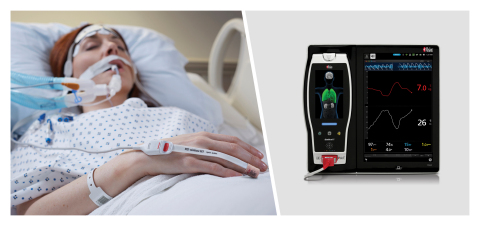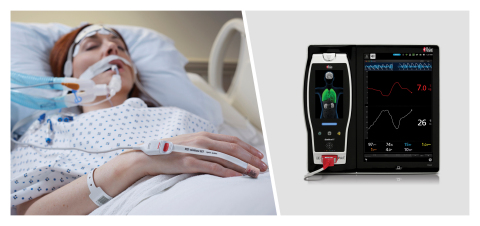IRVINE, Calif.--(BUSINESS WIRE)--Masimo (NASDAQ: MASI) today announced that PVi® has received FDA clearance as a continuous, noninvasive, dynamic indicator of fluid responsiveness in select populations of mechanically ventilated adult patients. PVi, or pleth variability index, is a measure of the dynamic changes in perfusion index that occur during the respiratory cycle.
William C. Wilson, MD, MA, Chief Medical Officer at UCI Health, said, “Anesthesiologists and critical care physicians have long recognized the importance of dynamic measures of intravascular volume and fluid responsiveness. Previously this data could only be acquired using an invasive arterial line, and/or additional sophisticated devices. With the Masimo pleth variability index (PVi), one can now obtain this essential data using the pulse oximeter probe and following the continuous readout on the monitor. The PVi technology has undergone rigorous peer-reviewed evaluation, and demonstrated efficacy in determining adequacy of intravascular volume for guiding goal-directed therapy. The recent clearance of the Masimo PVi system will serve as another major breakthrough in promoting patient safety.”
Available alongside Masimo SET® pulse oximetry and rainbow® Pulse CO-Oximetry on a variety of 2-LED, 4-LED, and 8-LED Masimo sensors, PVi is an index between 0 and 100 that is calculated using a proprietary algorithm based upon the relative variability of the pleth waveform.
Hospital protocols such as Enhanced Recovery After Surgery (ERAS) and Goal-directed Therapy (GDT) recommend fluid management as part of larger initiatives designed to improve patient care and safety. Fluid management protocols look to balance fluids by identifying when patients may be fluid responsive. The utility of PVi as a fluid responsiveness indicator has been demonstrated in more than 100 independent, published studies, including in ERAS and GDT protocols.1 For example:
- ERAS: In a study of 109 patients undergoing colorectal surgery, researchers found that the implementation of an ERAS protocol which included PVi led to substantial reductions in lengths of stay (from a median of 5 days to 3 days), complication rates (from 30.1% to 14.7%), and costs per patient (from mean cost at 30 days of $20,435 to $13,306 per patient)—in addition to improved patient satisfaction.2
- GDT: In a study of 82 patients undergoing major abdominal surgery, researchers found that GDT with fluid management using PVi reduced the volume of intraoperative fluid infused and reduced intraoperative and postoperative lactate levels.3
In addition, PVi has been used in combination with Masimo’s noninvasive, continuous hemoglobin monitoring technology (SpHb®). In a study published last year involving 18,716 surgical patients at a hospital in Limoges, France, researchers investigated the effects of implementing a hospital-wide protocol for fluid management and blood administration using PVi and SpHb. The researchers found that use of an integrated GDT algorithm using both PVi and SpHb led to earlier transfusion and fewer units of blood transfused, as well as a 33% lower mortality rate 30 days after surgery and a 29% lower mortality rate 90 days after surgery. A year after the study ended, when the hospital did not use PVi and SpHb technology, the mortality rate returned to levels similar to those found before implementation of the GDT protocol.4
Stephen Weston, MD, Health Sciences Associate Clinical Professor and Medical Director, Operating Room Support Services, Department of Anesthesia and Perioperative Care at the University of California, San Francisco, said, “At UCSF we display PVi on all of our Masimo pulse oximeters. PVi is a great tool for helping to assess the patient’s fluid status. Having a fluid responsiveness monitor incorporated into something as ubiquitous as pulse oximetry allows us to monitor fluid responsiveness universally. I integrate PVi into my routine sweeps of the hemodynamic data in the operating room, and we’ve rolled out this functionality to the intensive care units as well. Without PVi, I feel that I’m flying a little bit blind.”
Joe Kiani, Founder and CEO of Masimo, said, “We are thrilled that at long last we are able to offer clinicians and patients in the U.S. the full benefits of PVi monitoring. Multiple studies have shown how this breakthrough noninvasive indicator of fluid responsiveness can help improve outcomes and reduce costs on mechanically ventilated patients – with no more equipment needed than a software upgrade with most existing Masimo SET® and rainbow® platforms and the existing Masimo SET® sensors that so many top hospitals around the world already use for pulse oximetry.”
@MasimoInnovates | #Masimo
The accuracy of PVi in predicting fluid responsiveness is variable and influenced by numerous patient, procedure, and device-related factors. PVi measures the variation in the plethysmography amplitude but does not provide measurements of stroke volume or cardiac output. Fluid management decisions should be based on a complete assessment of the patient’s condition and should not be based solely on PVi.
SpHb is not intended to replace laboratory blood testing. Clinical decisions regarding red blood cell transfusions should be based on the clinician’s judgment considering, among other factors, patient condition, continuous SpHb monitoring, and laboratory diagnostic tests using blood samples.
The GDT and ERAS studies summarized above were conducted on patients undergoing specific types of procedures and following specific fluid management protocols. The results may not be reflective of all cases and the described GDT and ERAS protocols may not be appropriate for all types of patients and procedures.
About Masimo
Masimo (NASDAQ: MASI) is a global medical technology company that develops and produces a wide array of industry-leading monitoring technologies, including innovative measurements, sensors, patient monitors, and automation and connectivity solutions. Our mission is to improve patient outcomes and reduce the cost of care. Masimo SET® Measure-through Motion and Low Perfusion™ pulse oximetry, introduced in 1995, has been shown in over 100 independent and objective studies to outperform other pulse oximetry technologies.5 Masimo SET® has also been shown to help clinicians reduce severe retinopathy of prematurity in neonates,6 improve CCHD screening in newborns,7 and, when used for continuous monitoring with Masimo Patient SafetyNet™ in post-surgical wards, reduce rapid response team activations, ICU transfers, and costs.8-11 Masimo SET® is estimated to be used on more than 200 million patients in leading hospitals and other healthcare settings around the world,12 and is the primary pulse oximetry at 9 of the top 10 hospitals according to the 2020-21 U.S. News and World Report Best Hospitals Honor Roll.13 Masimo continues to refine SET® and in 2018, announced that SpO2 accuracy on RD SET® sensors during conditions of motion has been significantly improved, providing clinicians with even greater confidence that the SpO2 values they rely on accurately reflect a patient’s physiological status. In 2005, Masimo introduced rainbow® Pulse CO-Oximetry technology, allowing noninvasive and continuous monitoring of blood constituents that previously could only be measured invasively, including total hemoglobin (SpHb®), oxygen content (SpOC™), carboxyhemoglobin (SpCO®), methemoglobin (SpMet®), Pleth Variability Index (PVi®), RPVi™ (rainbow® PVi), and Oxygen Reserve Index (ORi™). In 2013, Masimo introduced the Root® Patient Monitoring and Connectivity Platform, built from the ground up to be as flexible and expandable as possible to facilitate the addition of other Masimo and third-party monitoring technologies; key Masimo additions include Next Generation SedLine® Brain Function Monitoring, O3® Regional Oximetry, and ISA™ Capnography with NomoLine® sampling lines. Masimo’s family of continuous and spot-check monitoring Pulse CO-Oximeters® includes devices designed for use in a variety of clinical and non-clinical scenarios, including tetherless, wearable technology, such as Radius-7® and Radius PPG™, portable devices like Rad-67™, fingertip pulse oximeters like MightySat® Rx, and devices available for use both in the hospital and at home, such as Rad-97®. Masimo hospital automation and connectivity solutions are centered around the Masimo Hospital Automation™ platform, and include Iris Gateway®, Patient SafetyNet, Replica™, Halo ION™, UniView™, UniView: 60™, and Masimo SafetyNet™. Additional information about Masimo and its products may be found at www.masimo.com. Published clinical studies on Masimo products can be found at www.masimo.com/evidence/featured-studies/feature/.
ORi and RPVi have not received FDA 510(k) clearance and are not available for sale in the United States. The use of the trademark Patient SafetyNet is under license from University HealthSystem Consortium.
References
- Published clinical studies on PVi, with varying results and outcomes, can be found on our website at http://www.masimo.com/evidence/pulse-oximetry/pvi. Studies include independent and objective studies which are comprised of abstracts presented at scientific meetings and peer-reviewed journal articles.
- Thiele RH et al. Standardization of care: impact of an enhanced recovery protocol on length of stay, complications, and direct costs after colorectal surgery. J Am Coll Surg. 2015 Apr;220(4):430-43.
- Forget P et al. Goal-directed fluid management based on the pulse oximeter-derived pleth variability index reduces lactate levels and improves fluid management. Anesth Analg. 2010 Oct;111(4):910-4.
- Cros J et al. Continuous hemoglobin and plethysmography variability index monitoring can modify blood transfusion practice and is associated with lower mortality. J Clin Monit Comp. 3 Aug 2019. https://doi.org/10.1007/s10877-019-00367-z.
- Published clinical studies on pulse oximetry and the benefits of Masimo SET® can be found on our website at http://www.masimo.com. Comparative studies include independent and objective studies which are comprised of abstracts presented at scientific meetings and peer-reviewed journal articles.
- Castillo A et al. Prevention of Retinopathy of Prematurity in Preterm Infants through Changes in Clinical Practice and SpO2 Technology. Acta Paediatr. 2011 Feb;100(2):188-92.
- de-Wahl Granelli A et al. Impact of pulse oximetry screening on the detection of duct dependent congenital heart disease: a Swedish prospective screening study in 39,821 newborns. BMJ. 2009;Jan 8;338.
- Taenzer A et al. Impact of pulse oximetry surveillance on rescue events and intensive care unit transfers: a before-and-after concurrence study. Anesthesiology. 2010:112(2):282-287.
- Taenzer A et al. Postoperative Monitoring – The Dartmouth Experience. Anesthesia Patient Safety Foundation Newsletter. Spring-Summer 2012.
- McGrath S et al. Surveillance Monitoring Management for General Care Units: Strategy, Design, and Implementation. The Joint Commission Journal on Quality and Patient Safety. 2016 Jul;42(7):293-302.
- McGrath S et al. Inpatient Respiratory Arrest Associated With Sedative and Analgesic Medications: Impact of Continuous Monitoring on Patient Mortality and Severe Morbidity. J Patient Saf. 2020 14 Mar. DOI: 10.1097/PTS.0000000000000696.
- Estimate: Masimo data on file.
- http://health.usnews.com/health-care/best-hospitals/articles/best-hospitals-honor-roll-and-overview.
Forward-Looking Statements
This press release includes forward-looking statements as defined in Section 27A of the Securities Act of 1933 and Section 21E of the Securities Exchange Act of 1934, in connection with the Private Securities Litigation Reform Act of 1995. These forward-looking statements include, among others, statements regarding the potential effectiveness of Masimo PVi® and SpHb®. These forward-looking statements are based on current expectations about future events affecting us and are subject to risks and uncertainties, all of which are difficult to predict and many of which are beyond our control and could cause our actual results to differ materially and adversely from those expressed in our forward-looking statements as a result of various risk factors, including, but not limited to: risks related to our assumptions regarding the repeatability of clinical results; risks related to our belief that Masimo's unique noninvasive measurement technologies, including Masimo PVi and SpHb, contribute to positive clinical outcomes and patient safety; risks related to our belief that Masimo noninvasive medical breakthroughs provide cost-effective solutions and unique advantages; risks related to COVID-19; as well as other factors discussed in the "Risk Factors" section of our most recent reports filed with the Securities and Exchange Commission ("SEC"), which may be obtained for free at the SEC's website at www.sec.gov. Although we believe that the expectations reflected in our forward-looking statements are reasonable, we do not know whether our expectations will prove correct. All forward-looking statements included in this press release are expressly qualified in their entirety by the foregoing cautionary statements. You are cautioned not to place undue reliance on these forward-looking statements, which speak only as of today's date. We do not undertake any obligation to update, amend or clarify these statements or the "Risk Factors" contained in our most recent reports filed with the SEC, whether as a result of new information, future events or otherwise, except as may be required under the applicable securities laws.




